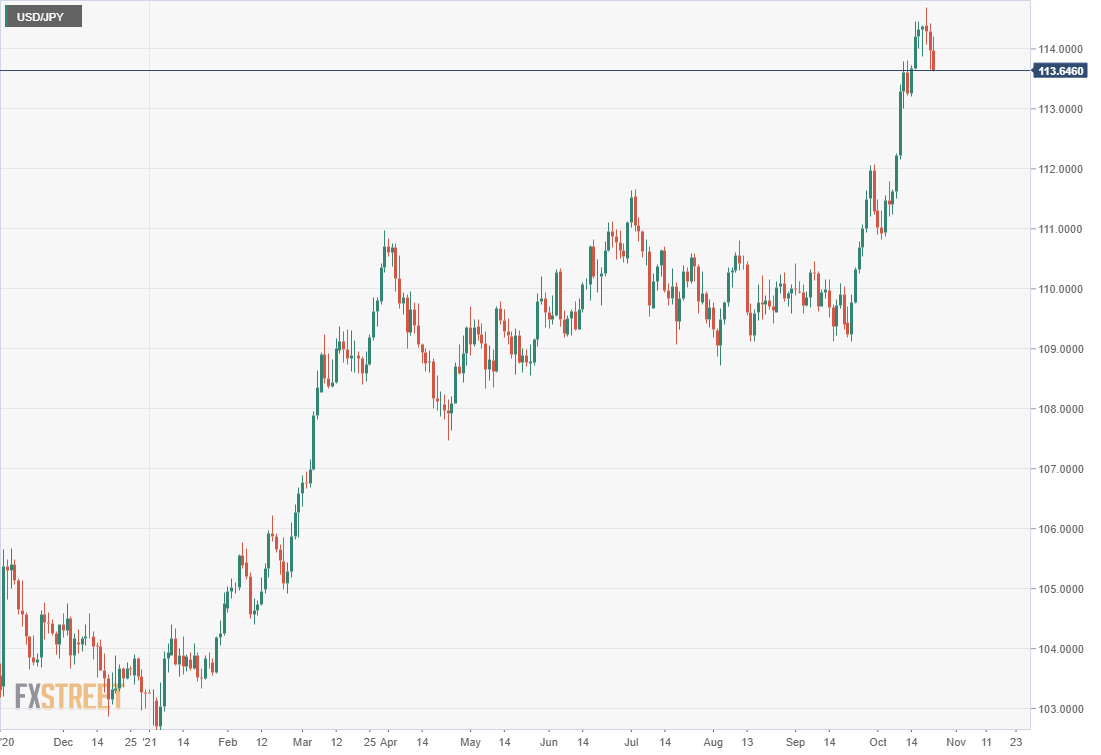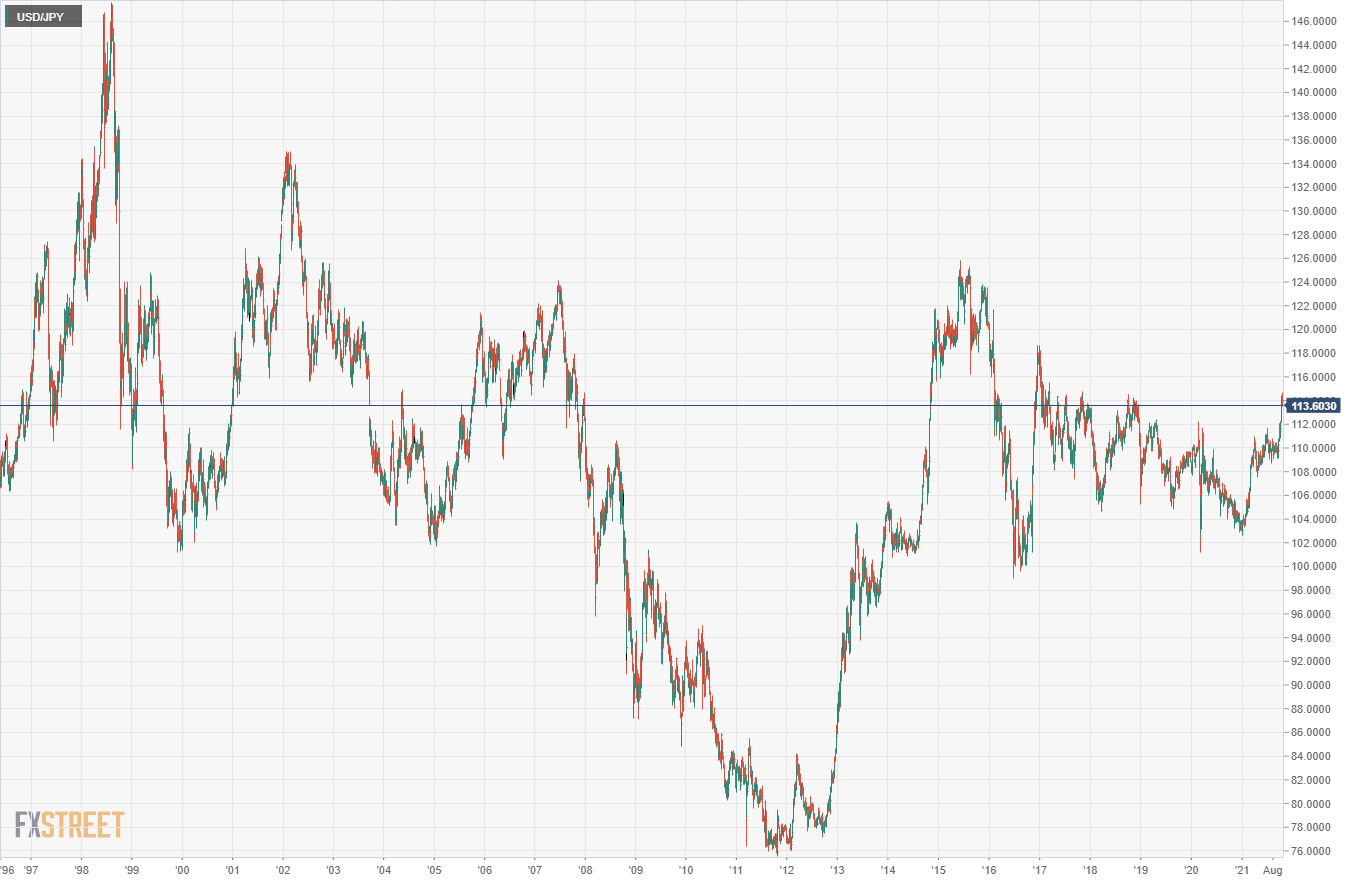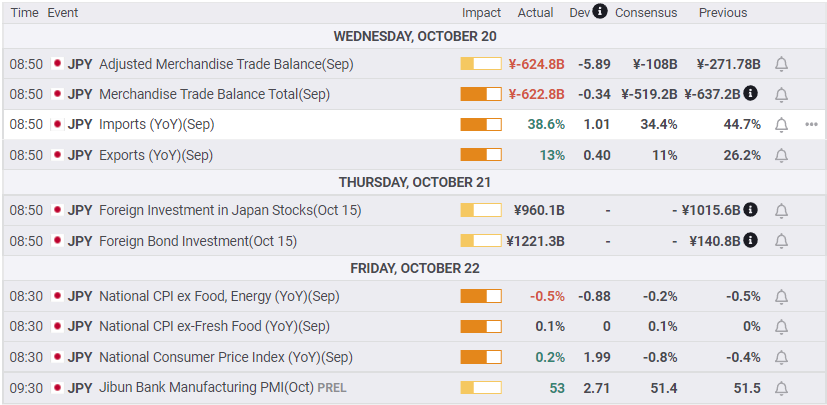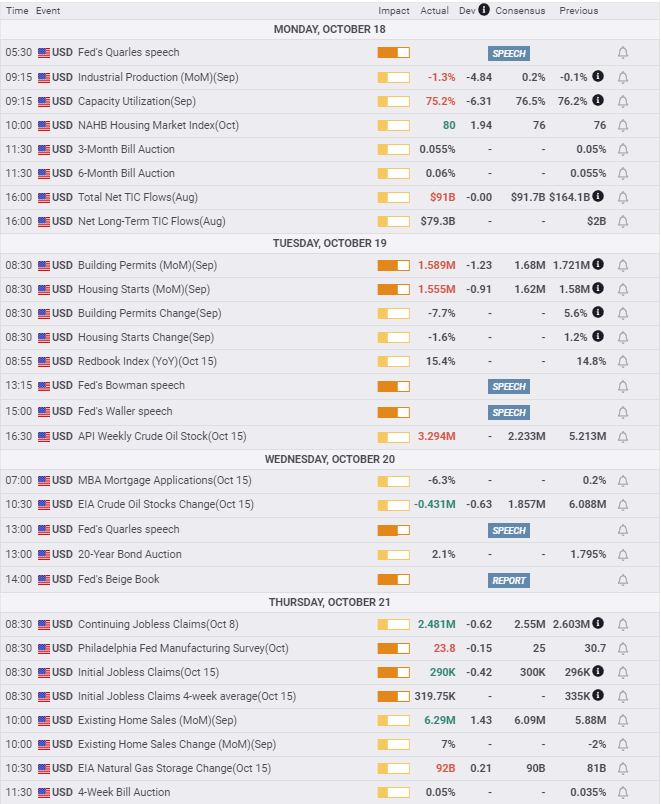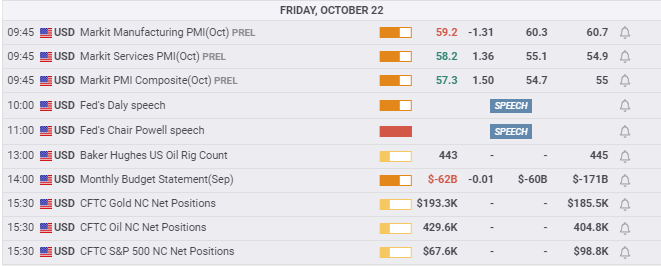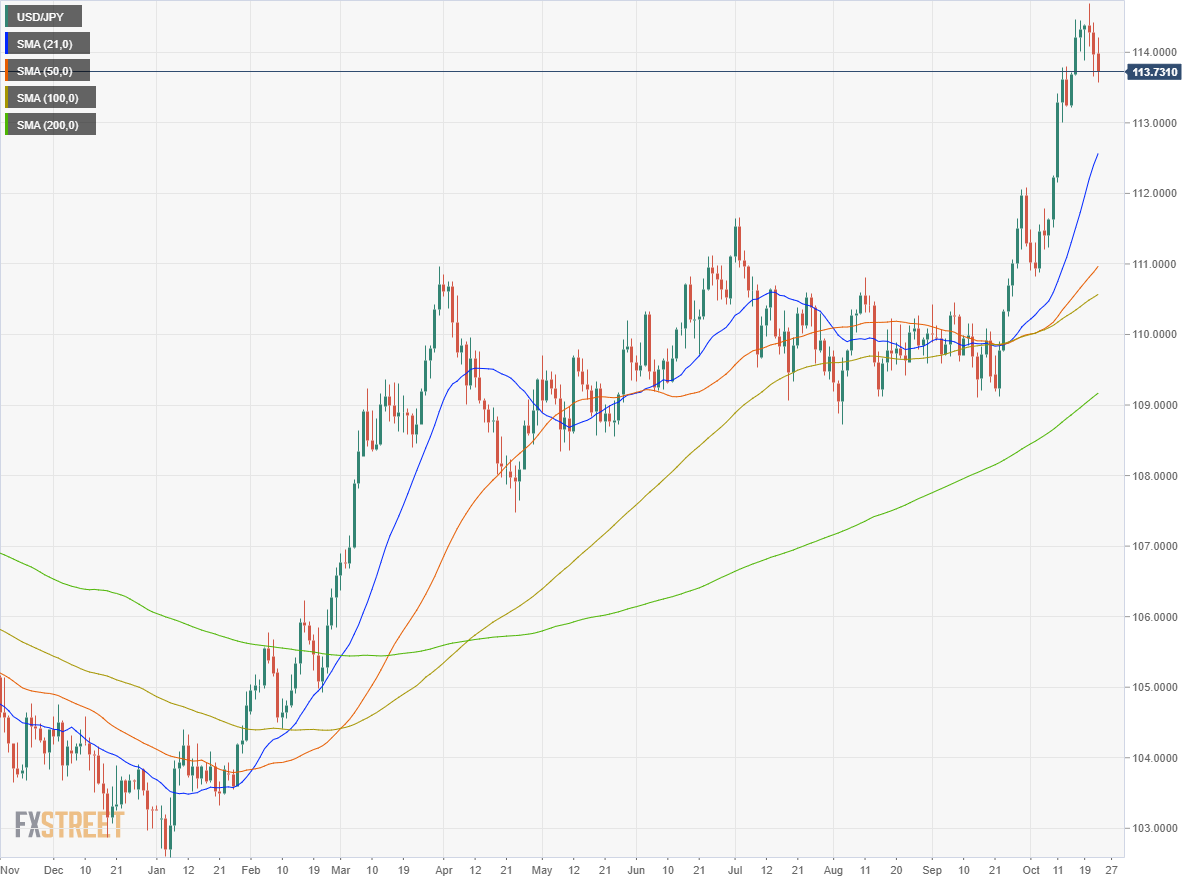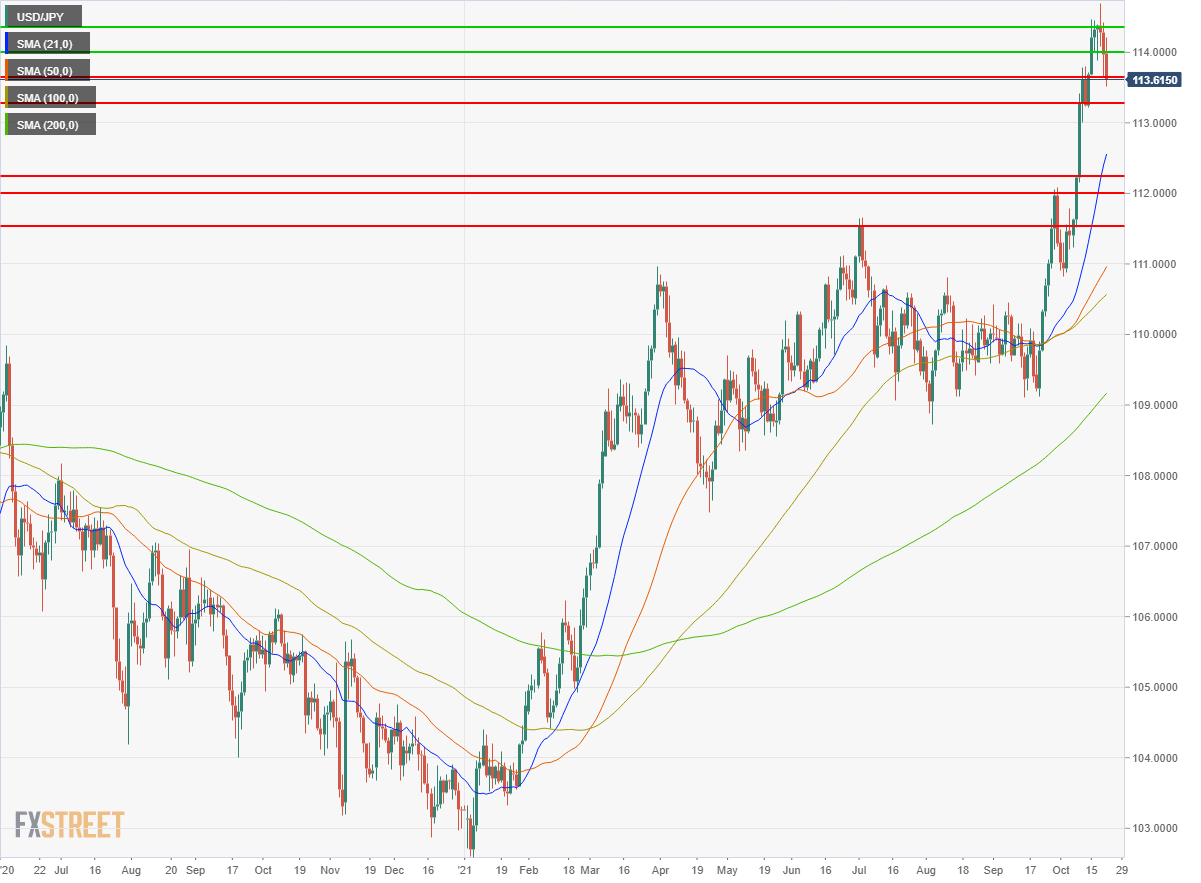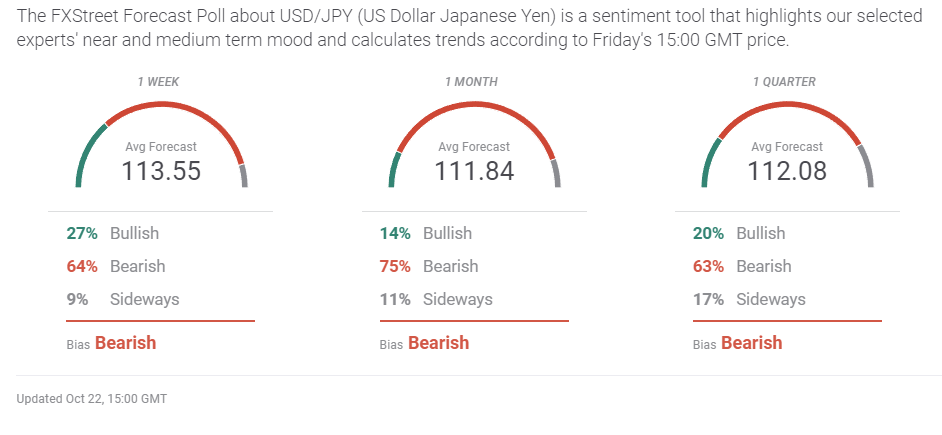- USD/JPY reaches 114.70 on Wednesday, a four-year high.
- 10-year Treasury-JGB spread widens by 7 points.
- USD/JPY encounters profit-taking, rebounds from support on Friday.
- FXStreet Forecast Poll is uniformly bearish out to one quarter.
After a month of torrid gains that extended to a four-year high at 114.70 on Wednesday, the USD/JPY executed a modest about face on Thursday losing about 40 points and closing just below 114.00. In its initial rebound, the USD/JPY keyed on the first support encountered at 113.65, underlying the still buoyant nature of the pair. On the week, the USD/JPY was slightly lower, opening at 114.20 on Monday and finishing on Friday at 113.56.
Over the last month, from the close on September 21, the day before the Federal Reserve meeting, the USD/JPY has gained 4.2%. Tuesday’s finish at 114.38 was the highest close since October 10, 2018. In comparison, the EUR/USD had lost just under 1% to Friday’s open and the sterling had gained a bit less than 1% in the same period.
The Japanese yen has been the weakest major against the dollar over the past four weeks since the Federal Open Market Committee (FOMC) meeting on September 22 and the primary reason is sovereign yields. The differential between the Japanese Government Bond (JGB) 10-year yield and the US 10-year Treasury has ballooned 28 basis points from its position on September 21. During that time the US-10 year yield has gone from 1.324% to 1.662% while the JGB equivalent has gone from 0.042% to 0.096%. This has increased the US 10-year Treasury yield advantage 7 basis points to 1.563%.
Interest rates are not the only logic behind the dollar’s ascendancy over the yen.
The worldwide computer chip shortage is expected to hit Japan’s export industries, especially automobiles, hard over the next six-to twelve months. Car shipments could fall 40% from last year.
Japan’s national election on October 31 is almost guaranteed to return the Liberal Democratic Party (LDP) candidate, current Prime Minister Fumio Kishida, to office. He has promised new fiscal and monetary stimulus programs to revive the Japanese economy. While the efficacy of these measures for invigorating Japan’s export-driven economy is questionable, their ability to keep the yen on the defensive is not.
Japanese economic data was mixed this week. Exports and Imports rose more than forecast in September but as the annual statistics are still recovering from the collapse last year, they are not indications of a strong recovery. Yearly Exports were down 4.9% in September 2020 and Imports were off 17.1%
National consumer prices rose for the first time in 11 months in September adding 0.2% on an expectation for a 0.8% decline and following August's 0.4% decrease. Core CPI dropped 0.5% (YoY), more than double the -0.2% forecast and equal to the prior month’s drop.
Industrial Production in the US sank 1.3% in September, far worse than the 0.2% prediction and Capacity Utilizations dropped to 75.2% from 76.2%. These coincide with the Atlanta Fed’s declining estimate for third quarter GDP now at 0.5%. It is down from over 6% in early August.
The US housing market remained effervescent, with Existing Home Sales, 90% of activity, jumping 7%. It is possible the threat of rising mortgage rates has motivated buyers to complete their purchases before the cost of buying a home increases..
The contrast between the strong, if uneven US economy, and Japan’s much slower recovery is another factor behind the gains in the USD/JPY.
USD/JPY outlook
All eyes have turned to the Federal Reserve’s November 3 meeting and the expected announcement of its bond program reductions. Treasury yields have moved steadily higher for the last month. The yield on the 10-year Treasury, the most important commercial referent, is less than 10 basis points below its March 31 high of 1.746%. An announcement from the FOMC, regardless of the initial amount or schedule, should keep US interest rates moving higher.
Japan’s sovereign yields are stagnant and are not about to mimic the gains in the US. That logic is the largest reason behind the surge in the USD/JPY.
The Bank of Japan and the Japanese government have, in the past, used the exchange rate to bolster the nation’s export industries.
Over the past quarter century the USD/JPY has varied from 145 to 77. At 114 the USD/JPY is near the midpoint of that range, as US yields rise and JGB returns plateau, the upper half of that territory is becoming more and more likely as a long term goal.
One suspects the BOJ and the Tokyo government would welcome such a devaluation. The bias in the USD/JPY is higher.
American data is expected to support the Federal Reserve case for commencing the bond taper. The Personal Consumption Expenditure Price Index for September is forecast to jump to 4.7%, the core rate to 3.6%, both records if correct. The consensus forecast for the first reading on third quarter GDP is 5.4%. The discrepancy to the Atlanta Fed GDPNow projection of 0.5% is notable and unusual. It would probably take a result near the Atlanta estimate for the Fed to delay its taper announcement.
The BOJ Interest Rate Decision, Monetary Policy Statement and Outlook Report have some potential for market impact. Prime Minister Kishida may have discussed his economic plans with BOJ officials as they likely involve bank actions. Any hints from the bank as to policy developments could weaken the yen.
Japan statistics October 18–October 22
US statistics October 18–October 22
FXStreet
Japan statistics October 25–October 29
FXStreet
US statistics October 25–October 29
FXStreet
USD/JPY technical outlook
The MACD (Moving Average Convergence Divergence) peaked on Monday, stalled on Tuesday and drifted down with the USD/JPY for the balance of the week. The Relative Strength Index executed a similar evolution, leaving overbought on Friday, having been in residence since October 11. That was the longest period in that status since late March and early April this year. Both averages remain active buy signals. True Range saw its highest moment on Thursday after small ranges on Monday, Tuesday and Wednesday and ebbed on Friday's reduction in points.
Despite the sharp turns higher of the 21-day (112.56) and 50-day (110.97) moving averages (MA) their distance from the market is testimony to the USD/JPY sprint after crossing 112.00 on October 8. The steep upward slope of these averages is their main contribution to the current technical picture.
The long gap between the 113.30 and 112.25 support lines, mirroring the open and closing rates for October 11, is a decided technical weakness should the USD/JPY drop far below 113.65 support.
The scarce resistance lines above Thursday's close at 113.88 did not prompt a further test of the upside after Tuesday's three-year record close at 114.38. Wednesday's test to 114.70 likewise indicated that, for the moment, momentum is dissipated. This is not surprising given the ascent of the last month is one of the steepest in a decade. Fundamental factors still heavily favor increases in the USD/JPY, but a breather is on order.
Resistance: 114.00, 114.35
Support: 113.65, 113.30, 112.25, 112.00, 111.55
FXStreet Forecast Poll
The rocket advance of the USD/JPY over the past month has boosted prospects for a technical reaction in the FXStreet Forecast Poll, absent a strong and continuing movement higher in US Treasury yields.
Information on these pages contains forward-looking statements that involve risks and uncertainties. Markets and instruments profiled on this page are for informational purposes only and should not in any way come across as a recommendation to buy or sell in these assets. You should do your own thorough research before making any investment decisions. FXStreet does not in any way guarantee that this information is free from mistakes, errors, or material misstatements. It also does not guarantee that this information is of a timely nature. Investing in Open Markets involves a great deal of risk, including the loss of all or a portion of your investment, as well as emotional distress. All risks, losses and costs associated with investing, including total loss of principal, are your responsibility. The views and opinions expressed in this article are those of the authors and do not necessarily reflect the official policy or position of FXStreet nor its advertisers. The author will not be held responsible for information that is found at the end of links posted on this page.
If not otherwise explicitly mentioned in the body of the article, at the time of writing, the author has no position in any stock mentioned in this article and no business relationship with any company mentioned. The author has not received compensation for writing this article, other than from FXStreet.
FXStreet and the author do not provide personalized recommendations. The author makes no representations as to the accuracy, completeness, or suitability of this information. FXStreet and the author will not be liable for any errors, omissions or any losses, injuries or damages arising from this information and its display or use. Errors and omissions excepted.
The author and FXStreet are not registered investment advisors and nothing in this article is intended to be investment advice.
Recommended Content
Editors’ Picks
AUD/USD remained bid above 0.6500

AUD/USD extended further its bullish performance, advancing for the fourth session in a row on Thursday, although a sustainable breakout of the key 200-day SMA at 0.6526 still remain elusive.
EUR/USD faces a minor resistance near at 1.0750

EUR/USD quickly left behind Wednesday’s small downtick and resumed its uptrend north of 1.0700 the figure, always on the back of the persistent sell-off in the US Dollar ahead of key PCE data on Friday.
Gold holds around $2,330 after dismal US data

Gold fell below $2,320 in the early American session as US yields shot higher after the data showed a significant increase in the US GDP price deflator in Q1. With safe-haven flows dominating the markets, however, XAU/USD reversed its direction and rose above $2,340.
Bitcoin price continues to get rejected from $65K resistance as SEC delays decision on spot BTC ETF options

Bitcoin (BTC) price has markets in disarray, provoking a broader market crash as it slumped to the $62,000 range on Thursday. Meanwhile, reverberations from spot BTC exchange-traded funds (ETFs) continue to influence the market.
US economy: slower growth with stronger inflation

The dollar strengthened, and stocks fell after statistical data from the US. The focus was on the preliminary estimate of GDP for the first quarter. Annualised quarterly growth came in at just 1.6%, down from the 2.5% and 3.4% previously forecast.
